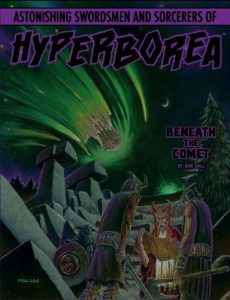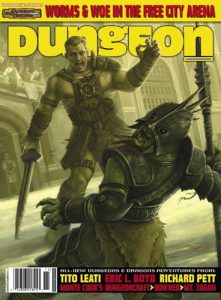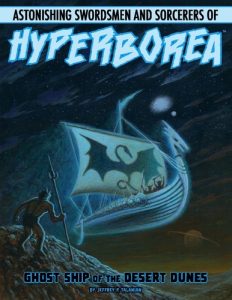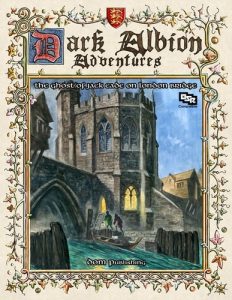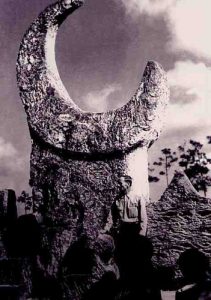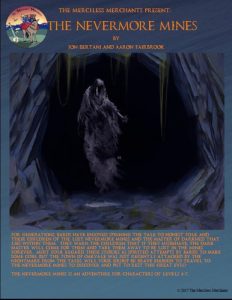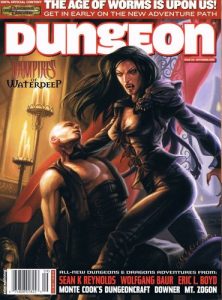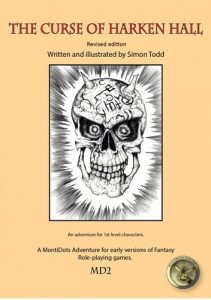
By Vance Atkins
Leicester’s Rambles
OSR
Low Levels
Two generations ago, a tragedy befell a wedding night. The groom was killed on the way to the wedding, leaving his grief-stricken bride to live out her days in heartbreak. Even after her death, she haunts her family home, seeking some sort of solace. The adventurers have arrived on the anniversary of the tragic night, where terrible forces bring devastation to the surrounding lands. Can the heroes enter the house and find a way to put an end to this annual horror?
This ten page adventure in a haunted house is a mashup of a bluegrass ballad, about a wedding widow, and a old house plan for a manor. There are about sixteen rooms scattered through about five pages, with the rest being overhead, introductions, licenses, etc. It’s got a decent, slow, haunted vibe going on but it’s handicapped by a loosely organized structure and a lack of focus for the room descriptions. With about sixteen rooms and about four monsters, with maybe four or five “other” encounters, there’s a slow burn thing going on. IE: Creepy adventure is creepy. It’s less D&D and more horror, lacking fantastic beasts, etc. That’s not a negative, but more of a setting-style, for those of you looking for a lower-fantasy adventure.
The backstory is relatively short and inoffensive, mostly because of the single column layout and the inclusion, taking up most of a page, of the inspirational bluegrass ballad. The map is a found object, a historical floorplan of a manor. It’s interesting, but also handicaps the adventure a bit. The key matrix is a mix of room names and numbers, all from the original map. By keeping the map ‘untouched’ you have to live with the original notations for doors, which look enough like windows to cause a bit of struggle to find them on the map. Other features, like ruined stairs and so on, rely on the text in the adventure to come across instead of being noted on a map. I can understand the allure of a found map, but it’s gotta be usable.
The stairs, in particular, annoy me. One stairway is gone, burned in a fire, we’re told a couple of times in a couple of places. That kind of makes sense since it’s not listed as stairs on the map … The front hall stairs, though … those are unusable also. They are collapsed and you need a grapple or something to make it up to the second level. But the stairs, unnumbered, look normal on the map. And the details of the stairs are only found in the text that introduces the second level. The collapsed stair thing is a nice obstacle, but the limitations of the found map shine through here. Instead of cueing the DM with a number on the stairs we instead rely on the DM reading an introductory paragraph.
I mentioned the writing style is unfocused. The first room, the courtyard, is six paragraphs long. One describes the various entrances to the home … I guess because of the map issues. Two delve, to various degrees in to “explaining why.” Adventures seldom, if ever, need to explain the why of things. It clogs things up. “The body of a ranger WHO ATTEMPTED TO PENETRATE THE GARDEN lies dessicated at the foot of one of the vines. (emphasis mine, of course.) The ‘why’ of the ranger is superfluous, it adds nothing to the play of the game. Likewise, earlier up, is this paragraph: “The rose vines have become imbued with chaos energy of the sorrow within the house. The vines are competitive and evenly spaced through the courtyard. Opportunists, they normally prey on birds, small animals, and whatever other unfortunate creature entered the courtyard due to the diminished soils and undead energies of the house.” We’ve already been told about the many small dead animals, earlier up. This paragraph does nothing but justify the existence of the vines. It’s explaining. Don’t explain. At best, one or two that intimate their sorrowful origin, if need be as flavor text, but an entire paragraph? It gets in the way of finding the information you DO need to run the courtyard. The adventure engages in this “explaining” and generally unfocused descriptions in most of the rooms.
It also does several things well. It provides hints, the rooms, in several places. One room has several animals in silk cocoons, for the observant, hinting at a spider. The courtyard, as mentioned, has several dessicated small animal bodies in it, hinting at the vampire vines. In another room you can see a peeling plaster ceiling with water stains, hinting at the weakened floor above.
Both this and U1/Saltmarsh have a nice creepy old house vibe. This one, actually BEING haunted, gets to stretch its legs a bit more than Saltmarsh. There are a couple of curses, including some nice creepy paintings and cursed treasures that appear as wealth to the players but black tar lumps to others, an unusual curse different from the usual pure mechanical effects most resort to. The ghost, proper, and her “curse removal” also has a nice folklore vibe going on.
I’m fond of these slow burn adventures. Or, maybe, I WANT to like these sorts of adventures. The idea of exploring an old haunted house appeals to me. I like the creepiness and build up. I’m not sure, though, it matches my play style. The slower place, and lack of “fantastic beasts” is going to appeal to some DM’s/campaigns more than others. Hmmm this is coming off more negative than I mean it to be. It’s a decent little adventure that needs a highlighter or a second version to tighten it up.
The last couple of pages on the DriveThru preview show you a couple of rooms, and is a good indication of what you are buying. Check it out:https://www.drivethrurpg.com/product/206724/The-Ballad-of-Sally-Anne?affiliate_id=1892600

